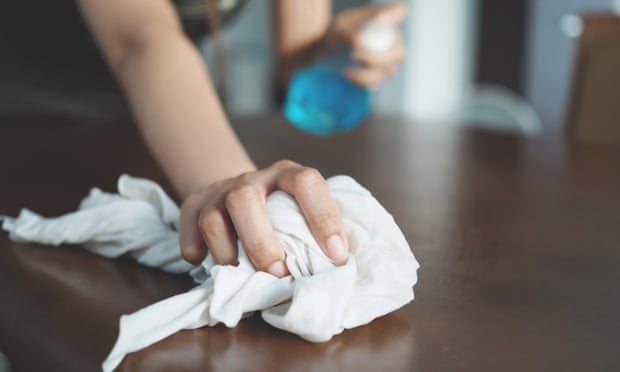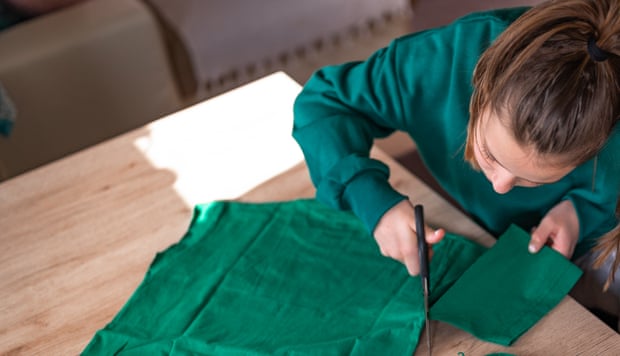
It’s hard to avoid the news about the mountains of textile waste we send to landfill every year but ICYMI, it’s 260,000 tonnes, or 10kg for each Australian.
The question of what to do with old clothes is a tough one. Landfill is a terrible place for them because they are made of precious resources and most won’t biodegrade for decades or longer. Ideally, we should sell or donate our old clothes, but this is only possible (or helpful for charities) if the garments are still wearable and desirable.
For clothes that are stained or threadbare and beyond hope, another option is to down-cycle them at home. Turning clothes into dishcloths, tea towels, mops and dusters is a way to reduce waste and save money. But not all fabrics have the same absorption properties, so your old T-shirt might be better than your old jeans for some tasks, and worse for others. Here, experts suggest which garments to repurpose for different household chores.
No matter the task: use natural fibres
When you’re cleaning, a certain amount of absorption usually helps. For this reason, Nicole Mallalieu, a fashion lecturer at the Australian College of the Arts, recommends ragging garments made from soft natural fibres such as cotton. When assessing if an old garment will make a useful rag, she says “to steer clear of anything that’s polyester or synthetic because it just doesn’t absorb as well”.
Timo Rissanen, an associate professor in fashion and textiles from the University of Technology in Sydney, says it’s important to stick to 100% natural or cellulose fibres such as viscose to reduce the risk of microplastic pollution from synthetic clothing shedding. “I suspect the abrasion in wiping also contributes to shedding,” he says.
T-shirts: good all-rounders
Saniyat Islam, a textile scientist from RMIT University, says T-shirts make great all-purpose cleaning rags because they are usually made of cotton, and they are durable, soft and absorbent. This means they perform well in the kitchen and can be used to wipe up grease and oil spills around the sink or oven.
Flannels: for dusting
Generally, flannel is a soft woven cotton that is very slightly fluffy, making it extra comfortable, which is why it is often used for pyjamas. That fluffy quality makes flannels a good candidate for dusting, says Islam, “as they have a brushed surface to catch dust particles”.
Rissanen also likes to use the bottom of his pyjama pants for rags. He says, “the lower legs of flannel pyjamas tend to be in good nick when the upper half has totally worn out”. The legs are also easy to cut off and turn into squares that make good tea towels.
Poplins: for polishing
Woven cotton poplin is a smooth fabric typically used in business shirts. Rissanen suggests using this for cleaning glass or mirrors “as it tends to give a better, smoother finish”.
Mallalieu agrees, saying “tightly woven cottons can be quite good when you want to get a shine on something”.
Heavier woven materials such as denim aren’t as good for polishing shiny surfaces but work well for leather and wood. Because denim is sturdy but still absorbent, it’s better at applying creams and wax polishes.
Deconstructing a garment
There are a few things to keep in mind when disassembling clothes into rags. Mallalieu says to start by cutting off all the buttons and any hard bits, then figuring out the main areas of the garment you want to use.

“A sharp pair of scissors makes the job easier,” Rissanen says. He starts by laying the garment as flat as possible on a table and then cuts away all seams, the neckline, the waistband and any other joins or uneven areas the garment might have. “I prefer not to have any seams etc in the rags as they can leave streaks on wet surfaces.”
Once the garment has been taken apart, if you’re dealing with sleeves or legs, be sure to cut along one side only as this will give you a larger rag that is easier to use.
Finishing touches
If you want to minimise fraying on your cleaning rag, there are a few ways to do this. Islam suggests cutting along the stitching and seams.
Mallalieu suggests doing a simple zigzag stitch along the edge of the fabric which will be very fast if you have a sewing machine. Then each rag can be stacked neatly in your kitchen drawers or in a box, ready to use.



